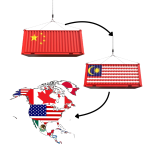In the intricate world of international relations and intelligence analysis, predicting crises or military actions relies on a spectrum of indicators, from satellite imagery to diplomatic communications. Among these, a peculiar and widely discussed concept known as the Pizza Index has emerged, capturing public fascination. This theory posits that a surge in pizza deliveries to key US government buildings, particularly the Pentagon, signals impending geopolitical events or military operations.
While the Pizza Index has historical anecdotes and recent social media buzz to bolster its popularity, its reliability as an intelligence tool is heavily contested. This article traces the evolution of the Pizza Index, examines its applications, critiques its limitations, and contrasts it with robust indicators used by professionals, particularly in the context of ongoing conflicts like the Iran-Israel tensions and the US B2 bomber strikes on Iran on June 21, 2025.
Origins and Evolution of the Pizza Index
The Pizza Index, often referred to as the Pentagon Pizza Meter, traces its origins to the Cold War era. Soviet intelligence operatives reportedly monitored food delivery patterns to US government facilities, believing that increased late-night orders indicated heightened activity, possibly linked to military planning. This practice was dubbed “Pizzint”, highlighting its informal yet intriguing role in espionage folklore.
The concept gained traction in the public sphere during the 1991 Gulf War. Frank Meeks, a Domino’s franchise owner in Washington, D.C., noted a dramatic increase in pizza deliveries to the Pentagon, White House, and State Department in the days leading up to the conflict. Meeks reported that late-night orders surged from an average of three to 101 at the Pentagon, suggesting officials were working extended hours . Similarly, on August 1, 1990, the night before Iraq’s invasion of Kuwait, the CIA ordered a record 21 pizzas, further cementing the index’s anecdotal credibility.
Over time, the Pizza Index evolved from a niche intelligence observation to a pop culture phenomenon, amplified by media coverage and social media platforms. During the 1990s, it was even referenced in reports like the “Pizza Meter,” a short-lived Domino’s initiative tracking delivery trends . Today, it is often discussed in the context of open-source intelligence (OSINT), where publicly available data is analyzed to infer government activities.
Recent Applications and Social Media Amplification
In the digital age, the Pizza Index has found renewed relevance, particularly on platforms like X, where users monitor delivery activity near government buildings to speculate about crises. A notable instance occurred on April 13, 2024, when a spike in pizza orders to the Pentagon, White House, and Department of Defense coincided with Iran’s launch of 300 drones and missiles against Israel in retaliation for an embassy bombing in Damascus. This event fueled online discussions, with users citing the Pizza Index as evidence of US involvement or preparation.
More recently, the US B2 bomber strikes on Iranian nuclear facilities on June 21, 2025, may have been preceded by similar delivery surges. Although specific data for this period is unavailable, social media posts on June 12 and 13, 2025, flagged increased activity at pizza outlets near the Pentagon, aligning with Israel’s Operation Lion airstrikes on Iran. These observations, while intriguing, remain speculative and lack the rigor required for intelligence analysis.
The Pizza Index’s modern application relies heavily on tools like Google Maps, which display real-time business busyness based on location data. However, this method introduces new challenges, as it does not directly measure pizza orders or identify customers, reducing its specificity.
Criticisms and Limitations
Despite its allure, the Pizza Index faces significant scrutiny from intelligence professionals. Marcel Plichta, a former US Department of Defense analyst, argues that the index fails under scrutiny due to its lack of context and flawed assumptions. For instance, it assumes that Pentagon staff order pizza exclusively during crises and that delivery spikes are attributable to them, ignoring other factors like routine meetings, training exercises, or social events.
Moreover, the index’s reliance on inconsistent data sources historically, direct reports from pizzerias, and now, aggregated location data further undermines its reliability. A Pentagon spokesperson recently dismissed the index, noting that staff have access to diverse food options, including sushi and sandwiches, suggesting pizza deliveries are not a definitive indicator.
Military analysts emphasize that the Pizza Index lacks the precision required for actionable intelligence. As noted in a New Arab report, actual assessments depend on tangible indicators like troop deployments, satellite imagery, and classified briefings, not food delivery patterns. The index’s popularity may stem from its simplicity and accessibility, but this comes at the cost of analytical rigor.
Reliable Indicators in Intelligence Analysis
In contrast to the Pizza Index, intelligence professionals rely on a structured approach to crisis prediction, using indicators categorized as strategic, operational, and tactical. Strategic indicators might include long-term policy shifts, such as sanctions or the suspension of nuclear talks, as seen in the lead-up to the June 2025 US strikes on Iran. Operational indicators involve military preparations, like the deployment of B-2 stealth bombers to Diego Garcia or the diversion of the USS Nimitz to the Middle East. Tactical indicators include specific actions, such as flight paths or communications intercepts.
Before the June 2025 strikes, several concrete signs pointed to US preparations. President Trump’s public statements, including calls for Tehran residents to evacuate and claims of control over Iranian skies, signaled heightened tensions. The State Department’s formation of a task force for US citizen evacuations further indicated contingency planning. These indicators, grounded in verified intelligence, provided a clearer picture than speculative delivery data.
Amos Yadlin, a former Israeli military intelligence chief, outlined four scenarios for the Middle East following Israel’s June 2025 strikes on Iran, highlighting the complexity of predicting outcomes. These scenarios ranging from a bilateral Israel-Iran war to a global conflict involving Russia and China underscore the need for precise indicators like military movements and diplomatic signals . Such analyses rely on a multi-signal approach, integrating OSINT, SIGINT, and HUMINT, rather than single, ambiguous metrics.
Conclusion
The Pizza Index, although it presents an interesting and accessible idea, is ultimately more akin to a myth than a feasible technique in the serious field of crisis forecasting. The historical anecdotes and more recent social media dialogues reveal perspectives on human behavior in stressful periods, but they do not meet the accuracy standards needed for intelligence assessments.
In volatile regions like the Middle East, where conflicts such as the Iran-Israel and US-Iran tensions demand accurate assessments, analysts rely on validated indicators like troop movements, diplomatic shifts, and intelligence evaluations to navigate complex geopolitical landscapes. While monitoring pizza deliveries can be amusing, the challenges of international security necessitate a commitment to stringent methodologies. The Pizza Index may spark curiosity, but it is the diligent work of intelligence professionals that truly sheds light on the path ahead in an unpredictable world.




